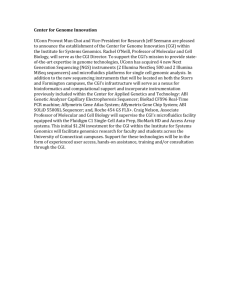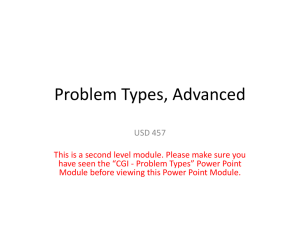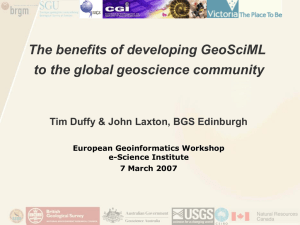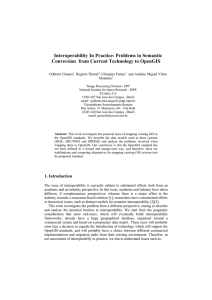How_to_map_data_to_GeoSciML
advertisement
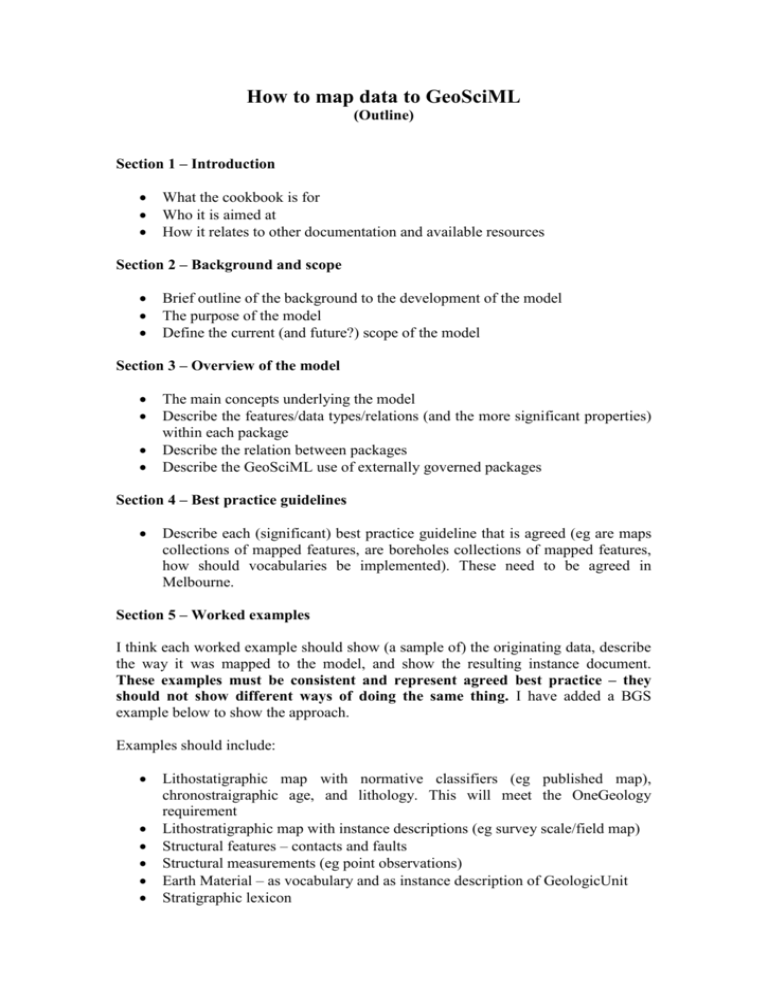
How to map data to GeoSciML (Outline) Section 1 – Introduction What the cookbook is for Who it is aimed at How it relates to other documentation and available resources Section 2 – Background and scope Brief outline of the background to the development of the model The purpose of the model Define the current (and future?) scope of the model Section 3 – Overview of the model The main concepts underlying the model Describe the features/data types/relations (and the more significant properties) within each package Describe the relation between packages Describe the GeoSciML use of externally governed packages Section 4 – Best practice guidelines Describe each (significant) best practice guideline that is agreed (eg are maps collections of mapped features, are boreholes collections of mapped features, how should vocabularies be implemented). These need to be agreed in Melbourne. Section 5 – Worked examples I think each worked example should show (a sample of) the originating data, describe the way it was mapped to the model, and show the resulting instance document. These examples must be consistent and represent agreed best practice – they should not show different ways of doing the same thing. I have added a BGS example below to show the approach. Examples should include: Lithostatigraphic map with normative classifiers (eg published map), chronostraigraphic age, and lithology. This will meet the OneGeology requirement Lithostratigraphic map with instance descriptions (eg survey scale/field map) Structural features – contacts and faults Structural measurements (eg point observations) Earth Material – as vocabulary and as instance description of GeologicUnit Stratigraphic lexicon Boreholes (need to define what types) What else???? Examples of examples Lithostratigraphic unit The Original Data: The Mapping method: 1. The map is a GSML collection of MappedFeatures, Each polygon on the map is one MappedFeature 2. The positionalAccuracy of the MappedFeature should be recorded or stated as ‘unknown’ 3. The observationMethod of each MappedFeature should be recorded eg ‘field observation’. There may be more than one observationMethod 4. The samplingFrame is the surface of mapping (Rockhead (geological)) 5. Each MappedFeature is specified using LithostratigraphicUnit 6. The gml:name should be used to record the name of the LithostratigraphicUnit 7. The observationMethod for the LithostratigraphicUnit as a whole, as opposed to the specific MappedFeature, should be recorded eg ‘Summary of published description’ 8. The ‘purpose’ is used to state whether the LithostratigraphicUnit description is for a normative definition (eg from a stratigraphic lexicon) or a particular instance 9. The preferredAge is used to record the age of the LithostratigraphicUnit either as a single value or as a range. Numeric values or chronostratigraphic units can be used 10. Composition is used to define the lithology of the unit, with values drawn from a list of defined lithology terms. A composition can be made up of multiple lithologies each defined by a ‘proportion’, defining the amount of each making up the whole (eg 100%), and ‘role’ (eg dominant constituent) The GeoSciML for the Lithostratigraphic Unit: - - - - <?xml version="1.0" encoding="UTF-8" ?> - <!-Example mapped feature from BGS data. --> <GSML xmlns="http://www.cgi-iugs.org/xml/GeoSciML/2" gml:id="mf.1" xmlns:xlink="http://www.w3.org/1999/xlink" xmlns:gml="http://www.opengis.net/gml" xmlns:swe="http://www.opengis.net/swe/1.0" xmlns:om="http://www.opengis.net/om/1.0" xmlns:sa="http://www.opengis.net/sampling/1.0" xmlns:cv="http://www.opengis.net/cv/0.2" xmlns:geox="http://www.opengis.net/geomExt/0.0" xmlns:xsi="http://www.w3.org/2001/XMLSchema-instance" xsi:schemaLocation="http://www.opengis.net/gml http://schemas.opengis.net/gml/3.1.1/base/gml.xsd http://www.cgiiugs.org/xml/GeoSciML/2 http://www.cgiiugs.org/xml/GeoSciML/2/geosciml.xsd http://www.opengis.net/swe/1.0 http://schemas.opengis.net/swe/1.0.0/swe.xsd http://www.opengis.net/cv/0.2 http://schemas.opengis.net/cv/0.2.0/cv.xsd http://www.opengis.net/om/1.0 http://schemas.opengis.net/om/1.0.0/om.xsd http://www.opengis.net/sampling/1.0 http://schemas.opengis.net/sampling/1.0.0/sampling.xsd"> <member> <MappedFeature> <positionalAccuracy> <CGI_TermValue> <value codeSpace="http://www.bgs.ac.uk/positionalAccuracyVocab">unknown< /value> </CGI_TermValue> </positionalAccuracy> <observationMethod> <CGI_TermValue> <value codeSpace="http://www.bgs.ac.uk/observationMethodVocab">fieldObser vation</value> </CGI_TermValue> </observationMethod> <observationMethod> <CGI_TermValue> <value codeSpace="http://www.bgs.ac.uk/observationMethodVocab">Boreholes </value> </CGI_TermValue> </observationMethod> - <samplingFrame> - <sa:SamplingSurface> - <!-Need MapHorizon specialisation here --> <sa:sampledFeature /> <sa:shape /> </sa:SamplingSurface> </samplingFrame> <shape /> - <specification> - <LithostratigraphicUnit> <gml:name>codeSpace="http://www.bgs.ac.uk/LithostratLexicon">DEEP CONGLOMERATE FORMATION</gml:name> - <observationMethod> - <CGI_TermValue> <value codeSpace="http://www.bgs.ac.uk/observationMethodVocab">Summary of published description</value> </CGI_TermValue> </observationMethod> <purpose>instance</purpose> - <preferredAge> - <GeologicEvent> - <eventAge> - <CGI_TermRange> - <lower> - <CGI_TermValue> <value codeSpace="http://www.bgs.ac.uk/geochronVocab">LOCHKOVIAN</valu e> </CGI_TermValue> </lower> - <upper> - <CGI_TermValue> <value codeSpace="http://www.bgs.ac.uk/geochronVocab">PRAGHIAN</value> </CGI_TermValue> </upper> </CGI_TermRange> </eventAge> </GeologicEvent> </preferredAge> - <composition> - <CompositionPart> - <lithology> - <ControlledConcept> <preferredName>CONGLOMERATE</preferredName> <vocabulary xlink:href="http://www.bgs.ac.uk/RCSVocab" /> </ControlledConcept> </lithology> - <proportion> - <CGI_NumericValue> <principalValue uom="percent">100</principalValue> </CGI_NumericValue> </proportion> <role codeSpace="http://www.bgs.ac.uk/roleVocab">dominantConstituent</rol e> </CompositionPart> </composition> </LithostratigraphicUnit> </specification> </MappedFeature> </member> - <member> </GSML>

